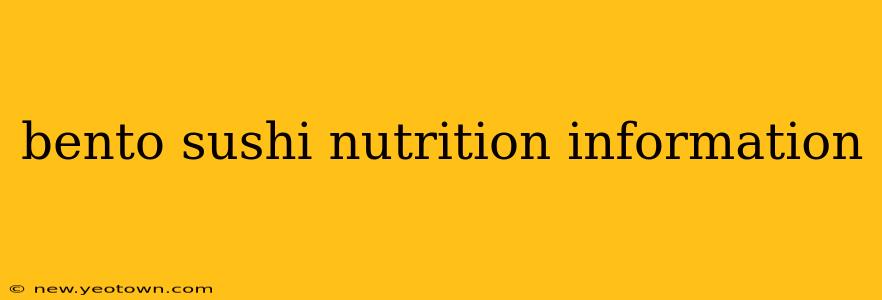The vibrant colors and meticulous arrangement of a bento box sushi lunch are a feast for the eyes. But beyond the aesthetic appeal lies a question many health-conscious individuals ponder: what's the nutritional value of this popular meal? Let's dive into the delicious details, exploring the nutritional components and addressing some common queries.
Imagine this: you’re enjoying a beautiful bento box, filled with perfectly formed nigiri, colorful maki rolls, and perhaps some refreshing edamame. It’s a satisfying meal, both visually and palatably, but does it truly contribute to a balanced diet? The answer, like most things in nutrition, is nuanced. It depends heavily on the specific ingredients and portions in your bento box.
What are the typical components of a bento sushi box?
A classic bento sushi box often includes a variety of elements: sushi rice (the foundation), various types of fish (salmon, tuna, yellowtail, etc.), seaweed (nori), vegetables (cucumber, avocado, carrots), and sometimes additions like pickled ginger (gari) and wasabi. The nutritional profile dramatically changes depending on what fillings you choose. A bento packed with fatty tuna and creamy avocado will have a far different nutritional makeup than one primarily filled with vegetable rolls and lean fish.
How many calories are in a typical bento box?
This is a tricky question without a precise answer. A simple bento with only a few pieces of sushi might clock in around 300-400 calories. However, a more elaborate bento with a wider variety of sushi, sides, and sauces could easily exceed 700-800 calories. The caloric content heavily relies on portion sizes and the ingredients selected. Think of the added calories from tempura or fried items often included in some bento boxes!
Is bento sushi healthy?
The healthfulness of bento sushi is highly variable. At its core, it can be a relatively healthy meal. Fish is an excellent source of omega-3 fatty acids, crucial for heart health and brain function. Seaweed provides essential minerals and fiber. However, the high carbohydrate content from the rice and the potential for high sodium levels from soy sauce need to be considered. Furthermore, the presence of fried ingredients or high-calorie sauces can significantly impact the overall nutritional profile, negating some of the inherent benefits.
What are the benefits of eating bento sushi?
When crafted with nutritious ingredients and mindful portion control, bento sushi offers several advantages:
- High in protein: Fish is an excellent source of lean protein, essential for building and repairing tissues.
- Rich in omega-3 fatty acids: These healthy fats are linked to reduced risk of heart disease and inflammation.
- Good source of vitamins and minerals: Seaweed, vegetables, and fish contribute various essential vitamins and minerals.
- Convenient and portable: Bento boxes offer a convenient and healthy meal option for busy individuals.
What are the drawbacks of eating bento sushi?
While bento sushi can be healthy, it’s crucial to be aware of potential drawbacks:
- High in sodium: Soy sauce is a significant source of sodium, and excessive sodium intake can contribute to high blood pressure.
- High in carbohydrates: Sushi rice is a carbohydrate-rich food, and overconsumption can lead to weight gain.
- Potential for hidden calories: Fried items, creamy sauces, and mayonnaise-based dressings can add significant calories and unhealthy fats.
- Mercury concerns: Some types of fish, especially larger predatory fish, can contain high levels of mercury. Opting for lower-mercury fish like salmon and tuna is recommended.
Are there healthier options within a bento sushi box?
Absolutely! Making healthier choices is all about mindful selection:
- Choose lean fish: Opt for low-mercury fish like salmon, tuna, and shrimp.
- Load up on vegetables: Incorporate plenty of vegetables for added fiber and nutrients.
- Limit fried items and creamy sauces: Choose steamed or grilled options over fried, and go easy on the sauces.
- Be mindful of portion sizes: Control your portions to manage calorie intake.
Ultimately, the nutritional value of a bento sushi box depends entirely on its contents. By making informed choices and focusing on fresh, wholesome ingredients, you can enjoy this delicious meal while also supporting your health and well-being. Remember, moderation and balance are key!

